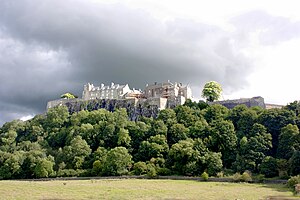Sieges_of_Stirling_Castle
Sieges of Stirling Castle
Part of the First War of Scottish Independence
There have been at least eight sieges of Stirling Castle, a strategically important fortification in Stirling, Scotland. Stirling is located at the crossing of the River Forth, making it a key location for access to the north of Scotland.
This article needs additional citations for verification. (September 2008) |
The castle changed hands several times between English and Scottish control during the Wars of Scottish Independence (1296–1357). In 1299, the castle was in English hands, when the constable, John Sampson, was besieged by the Scots. In 1304, Edward I of England besieged the Scots, deploying siege engines to force the garrison to surrender. In 1337, a siege by Sir Andrew Murray failed to retake the castle. Between 1571 and 1585, the castle was besieged three times by Scots factions during the reign of James VI. In 1651, Oliver Cromwell captured the castle during his invasion of Scotland. The final siege took place in 1746, when Charles Edward Stuart besieged the castle during the final Jacobite rising.
